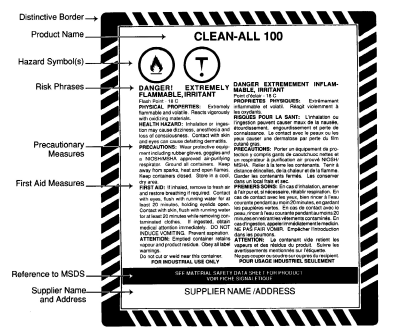Labelling is the first and most basic form of WHMIS hazard warning. A label is easily recognized and appears on the container of a controlled product. The label provides basic information about the risks associated with use of the material inside the container. A label also directs the reader to the SDS.
Two kinds of labels are required by WHMIS: Supplier Labels and Workplace Labels. Supplier and workplace labels have the same purpose, but differ from each other in content and format.
Supplier Labels
This type of label is most commonly used in construction and is known as the full information supplier label. It applies to all containers of hazardous materials with a volume of more than 100 millilitres.
The following are requirements on the supplier label:
- Product Identifier: Name of the product (common name, chemical name, generic name, trade name, brand name).
- Initial supplier identifier: Name, address and telephone number of either the Canadian manufacturer or the Canadian importer.
- Pictogram(s): Hazard symbol(s) that apply to the product.
- Signal word: A word used to alert users to a potential hazard and to indicate the severity of the hazard.
- Hazard statement(s): Standardized phrases that describe the nature of the hazard posed by a hazardous product.
- Precautionary statement(s): Standardized phrases that describe measures to be taken to minimize or prevents adverse effects resulting from:
- Exposure to a hazardous product, or
- Improper handling or storage of a hazardous product

Suppliers labels may also include supplemental label information that provides more details about precautionary actions, hazards not yet included in the GHS, physical state, or route of exposure.
Workplace Labels
A workplace label requires the following information:
- A product identifier that is identical to the one found on the hazardous product’s safety data sheet
- Safe handling information for the hazardous product
- A reference to the availability of an SDS (if applicable)

